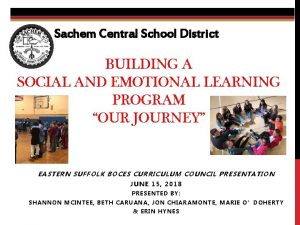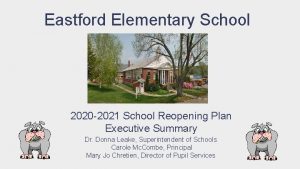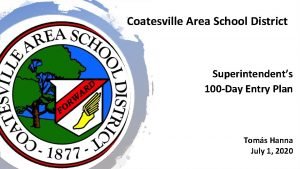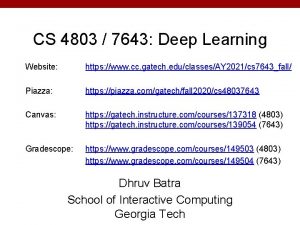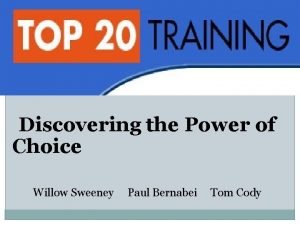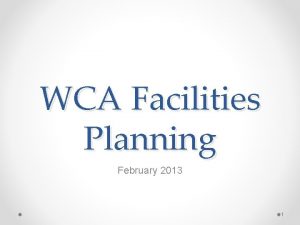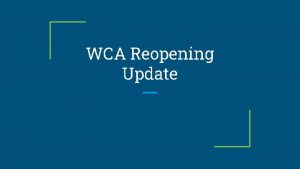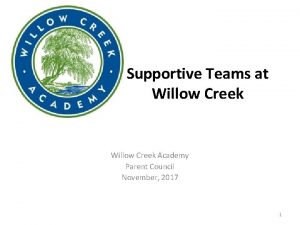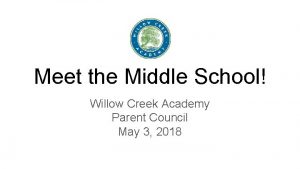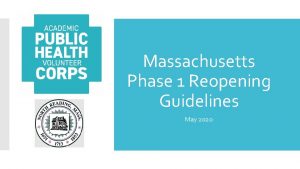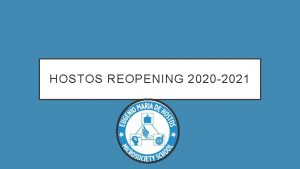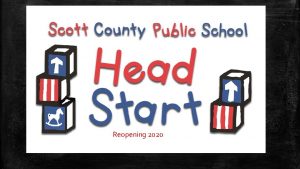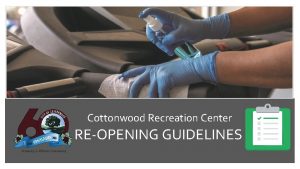Willow Creek Academy 2020 Fall Reopening Update WCA


















- Slides: 18

Willow Creek Academy 2020 Fall Reopening Update WCA Board Meeting 08. 04. 20

The Spring / Summer 2020 Rollercoaster Online school ordered through end of school year Bay Area Shelter in Place ordered though April 15 Governor announces 6 Indicators for lifting restrictions Crossing the Bridge (online) June 12 May 15 March 30 March 16 Black Lives Matter Protests begin May 18 CDC Releases Guidelines for returning to school June 30 th First Joint Board Study Session re: Unification June 18 Governor puts Marin on watchlist due to WCA recent spikes Reopening July 14 h July 3 July 6 th Second Joint Study Session re: Unification MCOE releases guidance for reopening calling for normal class sizes Third Joint Study Session re: Unification July 15 Aug 26 August 6 th Second Joint Study Session re: Unification July 21 st Second Joint Study Session re: Unification MCOE releases revised guidance for Phased Reopening starting with distance learning July 30 th Unification Town Hall

Current Guidance (July 15) California Dept of Public Health California Dept. of Education • California Guidelines • • Criteria for School Opening and Closures Dynamic Response Monitoring Marin County Health Department Marin County Office of Education • • Marin County Guidance Willow Creek Academy WCA Reopening Plan Start with remote Learning (as of 7/15) Phased Re-opening after September with small select cohorts on campus Social Distancing, Face coverings for all Daily Screening PPE provisions to all schools Cleaning and Sanitization Protocols Demonstrate ability to pivot btw states • • • . . WCA Guiding Principles & Planning Implications • • Equity and Access to Continuous Learning Campus Capacity Family and Staff Climate Nutrition and Food Fiscal Constraints Staff Constraints Unification

A continuum of responses depending on State and County health guidance • • Start school on August 26 th in fulltime distance learning mode - at least until Marin County gives green light for schools to bring students to campus. • Fulltime on-campus learning for most students with appropriate health and safety measures • Continuous remote learning option Currently investigating waiver from the State for K-6 to bring select groups to campus Distance Hybrid • • • Small Select Sanitary Cohorts (1: 12 or 1: 15) 3 Week Rotating A/B Schedules Middle School moves to block scheduling No cohort mixing Social Distancing Full PPE Enhanced Cleaning & Sanitization Remote Instruction only if requested Continuous Remote Learning Option Full On. Campus

WCA’s Reopening Guiding Principles 1. Health and Safety - The health and safety of staff and students is the single highest priority. 2. Equity & Access – All students and their families enjoy equal access to the tools they need to be successful learners, at home and at school 3. Academic Success – In-class instruction, assisted by on-line learning tools, provides the most effective, equitable learning environment for WCA students to meet learning objectives and access needed instructional support. 6. Procedures and Protocols - Specific safety protocols including daily health screening, temperature checks, restroom use procedures, paths of travel, outdoor recreation activities, substitute procedures, will be carefully planned, implemented, monitored and updated on a regular basis. 7. Social Emotional Support – Relationships and in -person connectivity are a critical component of social development for students, teachers and staff. 4. Stable Cohorts* - The core operational structure of 8. Flexibility & Transparency - WCA is ready to act WCA school programs is a stable cohort. . This structure helps to mitigate the spread of germs, enables health providers to trace contacts in the event of an infection, and isolates the need for potential closures. 9. Unification –Return to School planning is conducted in 5. Physical Distancing - For students, the cohort in itself is the physical distancing practice, however, measures must be taken to ensure safe distancing within the cohort itself to the extent practicable (preschool students and some students with special needs are not expected to maintain 46 ft. distance). quickly, decisively, and flexibly according to a set of clear protocols that are communicated effectively and responsive to the voices of our community collaboration with District leadership in consideration of school unification and what is in the best interest of all families in the district

Reopening Plan Highlights: High to Moderate Restrictions High Restriction Distance First: Phased Reopening beginning with Remote Learning through September • • Delayed school start until Wednesday August 26 th to allow teachers an extra week to prepare for both online and in-person instruction ‘Day in the Life’ On-line learning curricula and scheduled being developed during staff PD 8/13 – 8/25 with input from Moderate Restriction • When Marin County conditions improve, we will likely return with smaller sanitary cohorts of 12 or 15 kids per cohort, • This will be predicated on a tri-weekly rotational schedule. We will first phase in and prioritize oncampus full time instruction for those who received a "no mark" at the end of the year and/or whose family circumstance requires on-campus instruction for their children. • Remote Learning option continues for those with continued health concerns • If conditions worsen and guidelines change re: shelter-in-place, we will all pivot back to a remote learning model until restrictions are lifted. 6

Reopening Plan Highlights: Low Restriction • • ‘Normal school’ in which all students whose families are comfortable sending them back to campus can do so. • Class sizes are traditional but organized into ‘stable cohorts’ throughout the day to minimize exposure across groups and to facilitate tracking and tracing when required. • All K-8 students and staff wear face coverings both in the classroom and outside. 4 -6’ social distancing protocols in place throughout. • Enhanced handwashing, sanitization and cleaning protocols in place – staff, students and custodians • Arrival and dismissal times are staggered to minimize group interaction and choke points. Bathroom breaks are coordinated as are between class movement and recess. • Shortened on-campus school day. Elementary School 8: 15 - 2: 00 PM and the Middle School would run 8: 45 - 3: 00, with early release on Wednesday at 2: 00 Students whose parents opt to keep them home follow classroom instruction online. 7

Stakeholder Engagement: Surveys, Action Groups and Parent Coffee Workshops q q q 3 Board Updates re: Reopening 4 Morning Coffee Presentations & Discussions re: Opening 2 Parent / Family Surveys 1 Teacher & Staff Survey www. willowcreekacademy. org/ landing page with reopening plans, WCA communications and COVID-19 resources 3 Action Group Meetings 2 Steering Committee Updates to Parents via Blackboard Ongoing Coordination meetings with SMCSD Coordination with Community Partners Parent Calls (Starting week of 8/10 after survey findings) Community Partner Meetings (Sausalito Parks and Rec, Bridget the Gap, Marin Promise, Marin City and Sausalito Public Libraries, etc. )

Distance Learning: What We Heard Feedback Loop & Direct Actions ● Provide more direct teacher-to-parent communication ● Provide technology training/workshops for parents ● Provide daily assignment updates in a manner that is easy to understand ● Provide clear guidelines for students as to how to submit their assignments ● Increase the amount of synchronous instruction across all grade levels ● Ensure that parents have student passwords for Google classroom ● Provide a greater level of differentiation – for advanced learners and those struggling* ● Create a compact with clear norms for student participation during remote learning ● Provide more teacher facilitated small group instruction ● Provide more opportunities for student interaction/engagement with one another ● Take daily attendance, conduct regularly scheduled morning meetings across all grade levels with focus on Responsive Classroom / SEL ● Provide more unified schedules across all grade levels ● Assign “study buddies” ● Re-evaluate making “Elective Wednesday” for elementary students only 9

Core Interventions for At-Risk Students • This week, WCA staff will make personal phone calls to the families of all students working a grade level below or more in reading or math, or received a no mark/low engagement in the spring semester • During 10 -day staff PD, teachers (in collaboration with specialists/intervention specialists etc) we will create individual intervention plans for all identified students • Individual intervention plans will be communicated with parents and parents will receive regular progress updates • All students will be assessed at the beginning of the year remotely, using MAP and other online assessment tools to identify additional students at risk • Teaching teams will collaboratively review and update student plans bi-weekly • Specialists, intervention specialists, assistant teachers, student support staff will contribute as appropriate • Monthly student progress reports will be shared at regular board meetings

Core Interventions: Individual Student Plans • On-campus small group instruction, as allowed, or assigned to off-site “learning pods” • Small group and 1 on 1 intervention w/ intervention specialist + teacher for ELL/reading and/or math • Recorded Zoom instruction available for instruction review and/or preview • Student Engagement: Student voice + choice (Howler, passion projects, assessment, inquiry/PBL) • Online differentiation tools (video, differentiated text levels, audio, reading comprehension strategy tools) • Differentiated online reading and math programs with progress tracking (News. ELA, Reading Eggs, Dream. Box, No Red Ink etc. ) with small group explicit basic skill instruction • Online “Study Hall” for students needing additional support with work completion • Support from community partners (10, 000 degrees, Bridge the Gap, Marin City Library, etc. ) • SEL support to include positive incentives, study buddies, on-line clubs • Weekly one-to-one check-ins with student support specialists

WCA Stakeholder Outreach & Engagement Students • Family survey • Family Phone interviews • Student Orientations • FAQs Community Partners • Bridge the Gap, Marin Promise, Marin City • Conscious Kitchens • Meetings • Website • FAQs Parents & Caregivers • Family survey • Morning Coffee Zooms • Action Groups • Family Phone Interviews • Board Meetings • FAQs County Officials Teachers & Staff WCA Board • Board Study Sessions • Staff Survey • Head of School Report • Teacher and Staff Workshops • Action Groups • Blackboard Announcements • Professional Development • FAQs Board Civic Partners • Weekly calls re: guidance • Board Meetings and compliance • Website • Continuity of Learning • Civic resource planning Plan • Press Releases • Presentations • FAQs SMCSD & BMLK • District Board Meetings • WCA Board Meetings • Joint Study Sessions • Unification Town Halls

Curriculum - Remote Learning Key Themes & Opportunities • More professional development for teachers in remote teaching • Incorporation of SEL learning, promote sense of belonging (i. e. , daily openers, incentives for students to show up on time) • More early outreach to families of struggling students • Build in regular time for intervention • Reconsider ”elective Wednesday”, or make the 5 th day small group instruction/intervention • Provide options for on-line opportunities outside of regular curriculum • Tech “hotline” for students/families • After school online opportunities

How is reopening supporting unification ? We continue to collaborate with the district and BMLK around reopening to pave the way for unification • Joint Board Meetings • Joint curriculum planning • Joint Professional Development • Joint community outreach and support • Joint purchasing and fundraising • Joint facility planning and preparation 1 4

Campus Prep Update q Student capacity analysis at different cohort sizes q Room by room and campus site survey with facilities staff and superintendent 7/3 q Identified pinch points and safety mitigation measures q Identified, catalogued and shared necessary COVID-related work orders items for 7/31 completion q Validated campus readiness plans (screening stations locations and entries, directional flow, classroom layouts, outdoor classrooms) q Prepared COVID safety purchasing list q District cleaning, prep and deferred maintenance

(Draft) COVID Safety Purchasing List

Focus on May 1. Curriculum & Instruction 4. Safety & Compliance 5. Events & Partnerships 8. Staff Support & HR August Identify Action Group Review best practices for online and inclass instruction • • Clean out classrooms Assess issues and opportunities • • Instructional Strategy Gather and integrate additional input from teachers • Finalize Instructional plans and schedules • Identify Action Group • • ID best practices Assess issues and opportunities • Wellness Strategy • Share out social emotional wellness strategies • • • Capacity & Schedule Studies Meet with District & County Enrollment survey • • Parent survey Cohort & Schedule Scenarios ID pinch pints & strategies SD Key purchasing needs • • Schedule and cohort plan Cleaning & disinfectant plan Food service plan Afterschool & childcare • • • Site Preparedness Plan Site Visit from County Upgrade IT infrastructure Train staff / custodians Train parents and students • • Review State and County guidelines Identify pinch points • • Modify WCA protocols from CDE and County Guidelines Purchase PPE & supplies • • ID Staff & volunteer monitors WCA Compliance protocols Establish success metrics PPE and critical supplies • • Safety Plan Teacher/ Staff Training Student Training Parent training • • Develop Community Events Schedules Partnership around distance learning and community hubs • Parent Reopening Handbook • Prioritize CARE Funding Purchases • • • ID action group Review existing partnerships ID pinch-points • • Review State and County guidelines ID partnership opportunities • • ID Key WCA community events Joint WCA/BMLK events • Letter to staff and WCA Community with Steering Committee & Focus Areas • • Teacher survey Parent survey Options development COVID resource landing page • • • Communications protocols Communicate cohorts and cohort schedules Communicate family options • • Understand budget landscape Identify needs & constrains ID COVID-related grants Identify compliance legal issues • • Vote on 2020 -21 Budget Review CA budget impacts Fundraising needs & resources ID potential legal issues • • • Submit budget July 1 Targeted fundraising / grants Compliance and legal issues • • • ID action group Identify needs & constrains Identify legal issues • • • Staff survey Review best practices Identify individualized needs • • Draft staff support program Assess HR issues 6. Communications 7. Financial & Legal July • • 2. Social Emotional Wellness 3. Facilities, Operations & IT June • • Professional Development Implement and train staff

June Survey Highlights (New Surveys Coming Up) 124 parent respondents and 21 staff respondents Most important Factors for returning: • An improvement in school cleaning • Parents received most information from their teachers and • Access to hand sanitizer and increased hand washing from communications from the school • Classroom ventilation, filtration, and access to fresh air • Temperature and health checks • Do you feel safe returning (or sending your student • Face masks/shields back) in the fall? • 81% of parents said they were likely or highly likely Learning Models: to send their students back in the fall • The majority of parents prefer full-time in person learning • 48% of teachers said they feel safe returning, 43% (64), followed by hybrid (45) were unsure • The majority of teachers prefer hybrid (13), followed by full • Only 38% of parents felt positive or very positive time in person (6) about continuing distance learning. • 89% of teachers communicated with students at least once a day (often more), while only 40% communicated with • How did Distance Learning work for you (your child): families daily. • 47% of parents said it went okay, 25% said good, and 15% felt it did not go well Campus Options- Key Findings • 47% of teachers said good, 23% said okay, 10% said excellent (the remaining 4 responses wrote in • K-5 @WCA, 6 -8 @BMLK- 86 parents and 9 staff various answers, none saying it didn’t go well) • K-5 @BMLK, 6 -8 @WCA- 23 parents and 6 staff • Kinder @ both, K-5 @WCA, 6 -8 @BMLK- 26 and 2 staff • If we were to continue distance learning, 66% of • Kinder @ both, K-5 @BMLK, 6 -8 @WCA- 7 (not included parents felt their student would need more academic on Spanish or new survey) and 3 staff support
 Is an alternative of log based recovery.
Is an alternative of log based recovery. Ibm campaign knowledge center
Ibm campaign knowledge center Bloomfield hills schools reopening
Bloomfield hills schools reopening Erin hynes sachem
Erin hynes sachem Lincoln parish school board
Lincoln parish school board Reopening plan
Reopening plan Coatesville area school district
Coatesville area school district Buffalo public schools reopening plan
Buffalo public schools reopening plan Merrimack school district reopening
Merrimack school district reopening Fall creators update whats new
Fall creators update whats new Cs61c fall 2020
Cs61c fall 2020 Cs 7643 fall 2020
Cs 7643 fall 2020 Cs61c fall 2020
Cs61c fall 2020 Structure of twelfth night
Structure of twelfth night Ronald is a teddy bear figure of speech
Ronald is a teddy bear figure of speech Willow sweeney
Willow sweeney Willow and ginkgo poem analysis
Willow and ginkgo poem analysis Weeping willow exploration 1
Weeping willow exploration 1 Willow grove hoa
Willow grove hoa



